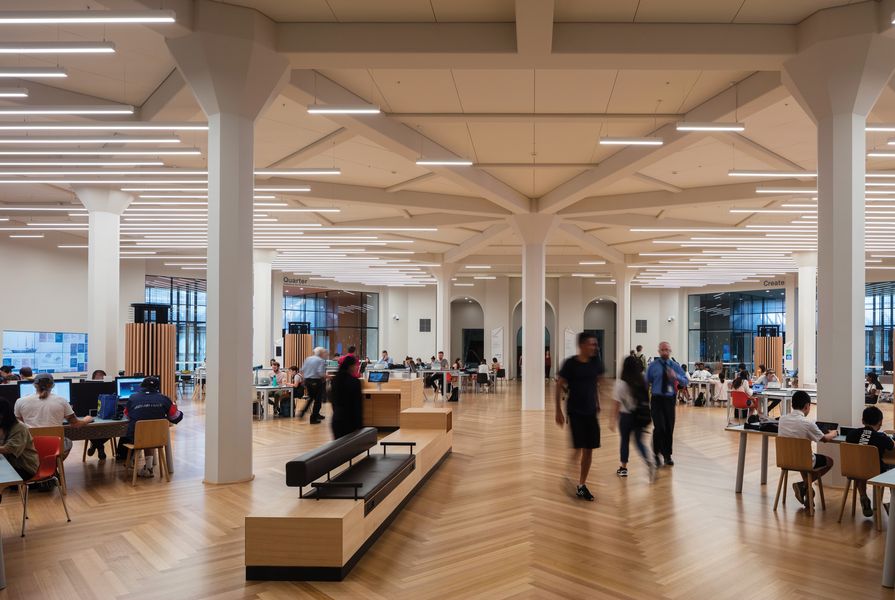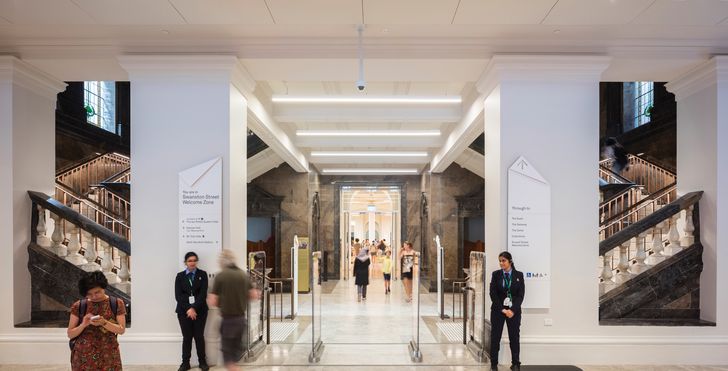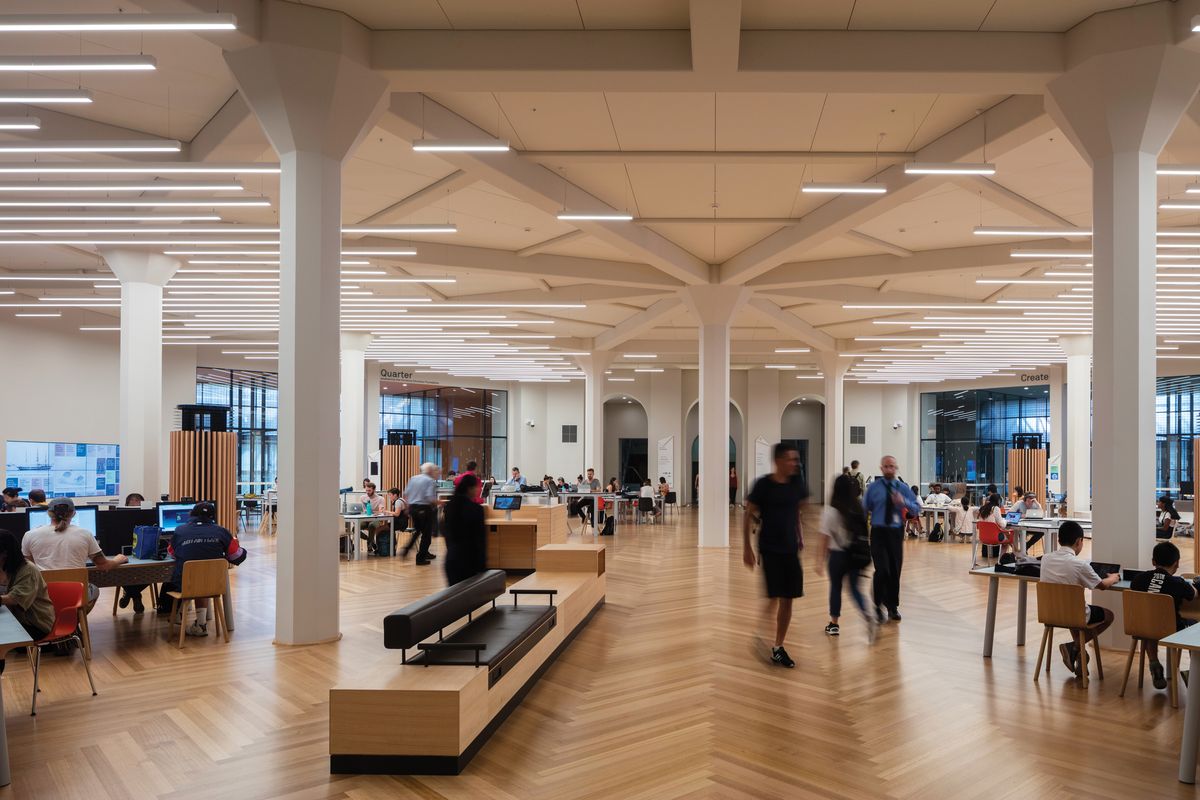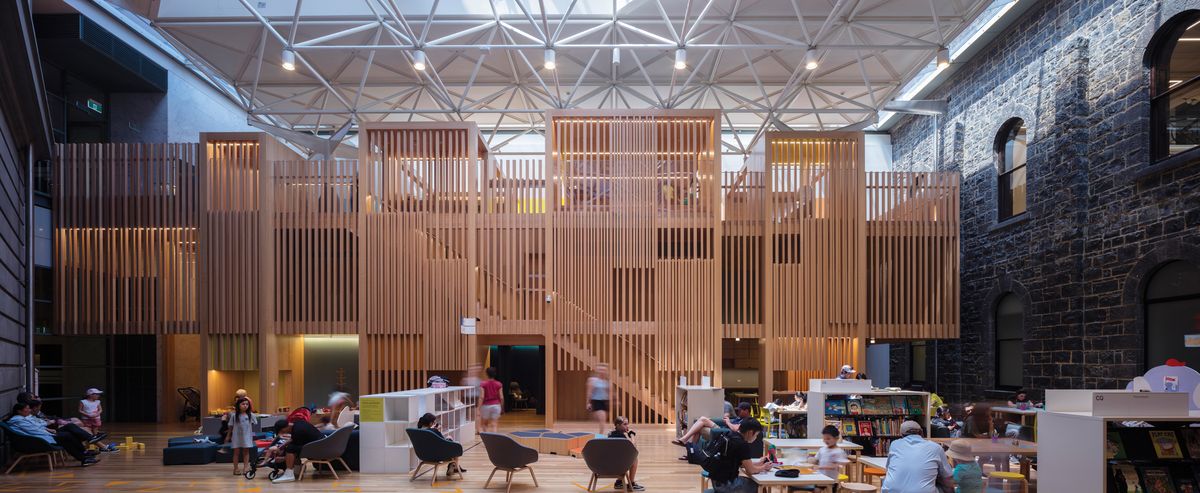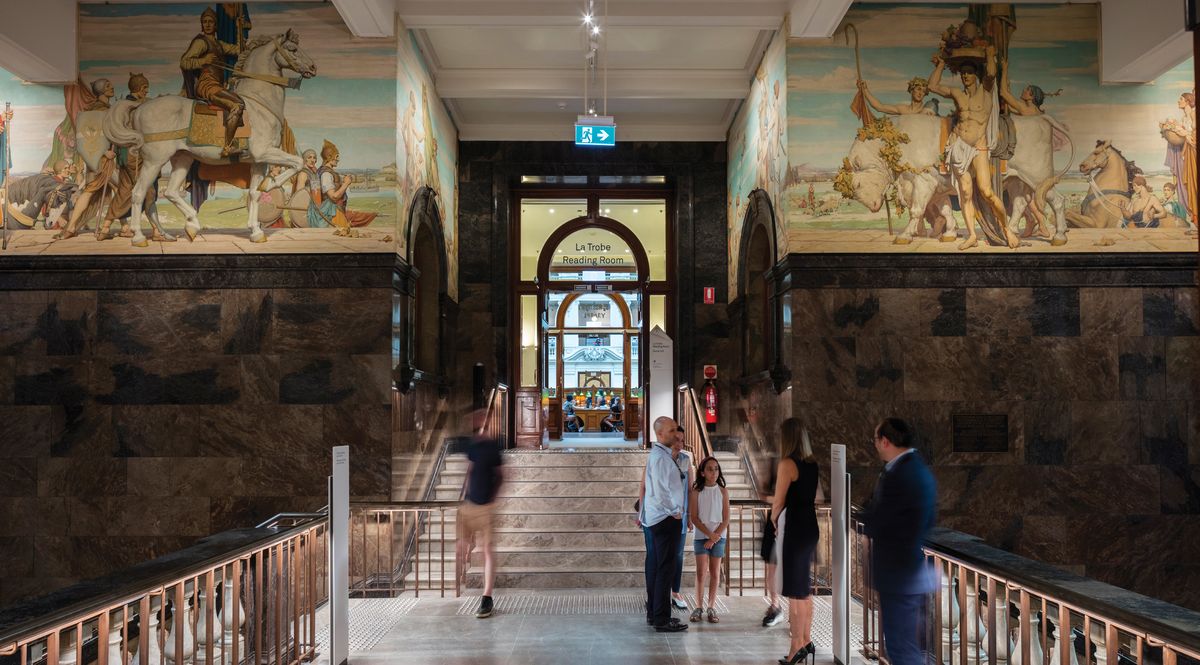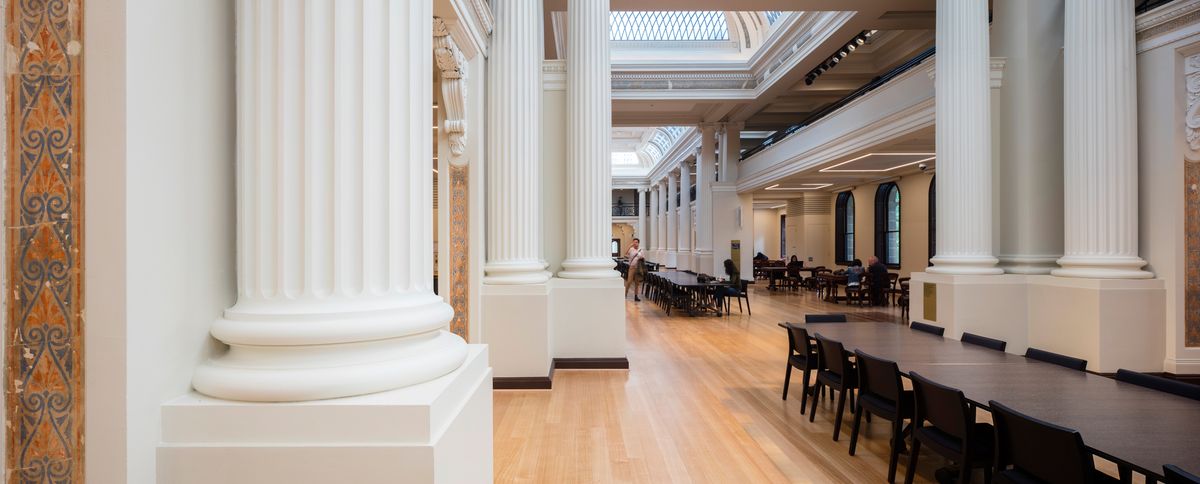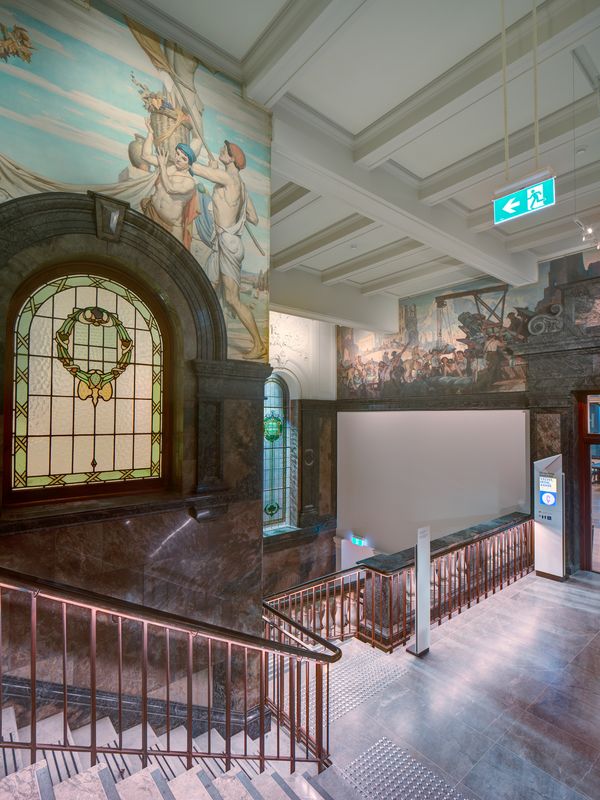The State Library of Victoria (SLV), fronting Melbourne’s Swanston Street, covers an entire city block. Founded in 1854 and opened in 1856, it has a fascinating and complex history, sharing its site, at times, with the institutions now called Museum Victoria and the National Gallery of Victoria. The precinct felt like another world prior to the most recent renovation, which began in 1985. Inside the Domed Reading Room (opened in 19131 ), sparrows and starlings flew around the ceiling. The room’s breathtaking internal streetscape included ghost facades sculpted inside its octagonal drum. A remarkable suite of Edwardian Baroque furniture was lit by rows of feeble bulbs, with students and homeless people alike hunched over desks in constant twilight. To borrow an item, you lined up in the old first-floor catalogue room, full of wooden chests of handwritten cards. Dust-coated men hastened up and down a spiral stair into Piranesian caverns in the stacks, fetching items from cabinets, tables and tallboys.
Since finances had been frozen in the 1920s and ’30s, the library had spent decades simply trying to survive. Working there gave you a splitting eyestrain headache, except in the one more modern interior that was the La Trobe Library (now the Conference Centre) – a deeply optimistic, rubber-floored, bronze-windowed tribute to Swedish architect Gunnar Asplund. Begun in 1951, it took 14 years and three recessions to complete. In the 1960s and early ’70s, trainee librarians were routinely shown through Australia’s “heartbreak library” – still a tangle of museum, gallery and library, largely spread along hallways. The gallery shifted in 1968 but the museum remained. In 1985, a competition was held in an attempt to rejuvenate the building.2
A masterplan by Ancher Mortlock Woolley won the competition, and the practice designed most alterations up to 2010. It filled in the block’s unfinished exteriors (two La Trobe street frontages), refitted the museum’s old McCoy Hall (1892) as the Redmond Barry Reading Room, uncloaked and rebuilt the Dome’s skylights (which had been damaged and closed over in 1959) and reshaped the present Cowen Gallery (built in various stages between 1892 and 1941) – now a lively and well-visited space showing off Melbourne and Victoria through the library’s own notable collection. They refitted the catalogue basement (constructed between 1907 and 1913), giving it a touch of Otto Wagner with Dalek air vents, marble panelling and gold studs. The weak point was the corridor and vestibule treatments: mostly dim, dark and indifferent.
The Swanston Street foyer, refurbished during the Vision 2020 works, was part of the Library’s original 1856 building.
Image: Brett Boardman
The Vision 2020 plan (2017–20), funded by the Victorian government and philanthropic donations, supplanted the Ancher Mortlock Woolley masterplan in 2017. In a limited competition, Architectus, with the Danish firm Schmidt Hammer Lassen, was selected to design the redevelopment. With Andronas Conservation Architecture as heritage consultants – building on Lovell Chen’s earlier heritage studies and strategic plan (1985–2012) – the team has completed a comprehensive second-stage refurbishment, revitalizing 15 of the 28 major spaces on the Library’s current map. Its signature is the restored Ian Potter Queen’s Hall, the earliest reading room behind the 1869–70 portico.3 The work also includes the great polished stone stair (1906–13) leading up to the octagonal Reading Room Dome; Hansen Hall (1863–64), between Mr Tulk cafe (1961) and the main entrance; the interstices between the Dome and the squared wings around it; and the Isabella Fraser Room, a function area on the La Trobe Street frontage. The former Trescowthick Information Centre has been reconfigured as the Quad, and the library’s four triangular courtyards (three of which were roofed in the 1990s) have been repurposed.
The new surfaces gleam as if built yesterday. Several spaces look bare on initial impression: in their new uniformity of colour, Queen’s Hall, Hansen Hall and the genealogy and arts collections appear almost as if waiting for occupancy, waiting for something to happen. But isn’t that what a library should suggest? And its new occupancy is only just unfolding, after all. These interiors leave room for the library to grow into them, visually and in memory. The architects’ work for Vision 2020 is not externally focused, as Ken Woolley’s work had been. Ancher Mortlock Woolley’s internal spaces were clean-ups, with the fitouts strictly framed by the basic structure. Architectus and Schmidt Hammer Lassen Architects has sustained a lighter hand; its refurbishment is more playful and kinetically relaxed, improvising on circumstance, working changes through and around the basic structure.
The new work gives each new space a distinct narrative character and offers many surprises. One signature motif is timber plank fabric, which never meets the basic wall or roof structures but is set hovering between them – often, as in the Pauline Gandel Children’s Quarter, with varied transparency across its envelope. In sheer presence, the Children’s Quarter, which replaced the 1963 Melbourne Planetarium, recalls Gunnar Asplund’s children’s space at Stockholm Library (1928), though that is a small, apsidal womb and this is a converted courtyard. At SLV, the Children’s Quarter is both a singular, protective realm – despite a high roof – and a terrain of adventure, with curl-up alcoves in a layer literally under the stairs at ground level (four bays) and eyrie-like stages at first-floor level (again, four bays, each with monumental timber canopies). One bay surrounds and celebrates a space-frame column; at the other end, a similar column is left out on its own. In the Quad reading and computer area, the tables, chairs and seat groupings all change form casually around the octagonal space, breaking from the expected segment divisions, taking on their own pattern. The lighting strips above them cut across the ceiling’s original net of reinforced concrete Kahn bars but are kept light enough in grain and interval to show, in contrast, the older structure. The air registers, similarly, are now wrapped in Aalto-like timber blades.
Architectus and Schmidt Hammer Lassen Architects’ brief shifts several other spaces around: lecture and seminar spaces are all moved to the Quad’s north side. The new Victoria Gallery is shaped from the service area on the north-east side, and the classicist Russell Street entry (surprisingly austere for 1906) is completely reworked inside, with the bookshop to one side and a new cafe on the other.4 By surrounding the bookshop with a mesh curtain of three-millimetre steel rods, Architectus and Schmidt Hammer Lassen Architects has been able to keep the original, cuboid space while simultaneously generating movement and a rather festive sense.
The Newspapers and Family History Reading Rooms (combined in a shared gallery) have shifted south of the Redmond Barry Reading Room, and the Arts Reading Room has been positioned alongside; both are long, pure white spaces. The former first-floor catalogue room is now a quiet reading lounge and, in another surprise, its spiral stack stair has been partitioned off to create a separate space at the Quad and Dome entrances. These new spaces – the lounge, furnished appropriately with armchairs and low tables; and the stair as a surprise in the entry vestibule corner, lifted from its old role yet reminiscent of it – reflect Architectus and Schmidt Hammer Lassen Architects’ approach to the library and its many chapters.
Between the Quad and the west foyer sits the long-closed grand stair to the Dome and Queen’s Hall, a ceremony in polished stone. Its west wall carries Harold Septimus Power’s War mural (1924), its east Napier Waller’s Grecian Peace after victory (1929); both embody the “memorial city” mood of that period. The challenge for the architects was to add stairs and balustrades that meet current safety standards. The new tissue, copper-bronze metal, stone treads and balustrading are bold but also look surprisingly right, creating a gleaming river of energy that cascades down through the original stair and its panelling.
The Queen’s Hall has a long, newly revealed skylight ceiling in coved, diamond-pane clear glass, shielded from hail and rain by an outer canopy in polycarbonate that is unseen from either the street or the inside. (The glass in the skylights in the original hall was shattered during a thunderstorm in 1901, although the skylights remained in place until the early 1970s.) Ionic three-quarter columns, newly accentuated, give the hall a spine and, as originally, frame book bays (which include a considerable chess and bridge collection) based on the eighteenth- and nineteenth-century shelved alcove model. The shelves are now half-height and less obvious, allowing a greater sense of lateral space. The centre-aisle tables, movable for functions, are new and plain; the Victorian tables, massive and intricate in their hinged lecterns and leather detailing, now sit unobtrusively in four- and six-seat bays along the west wall. The late 1980s alterations revived Victorian pastel layering à la English architect and designer Owen Jones. The plain new colouration is Architectus and Schmidt Hammer Lassen Architects’ boldest move here; it dramatizes the former inset panels and gallery friezes, with their carefully uncovered nineteenth-century patterning and colours.
What marks this refurbishment is the architects’ willingness to go with the building’s idiosyncrasies and episodes. The work recognizes that large institutional buildings such as this carry inside them their own history and culture, and that refurbishment is as much a weaving, a negotiation, as an outright renewal.
— Conrad Hamann is associate professor in architectural history and history of urban form at RMIT University. He worked in the State Library of Victoria almost every week between 1972 and 1999, and he has often worked there since. He is the author of five books and about 130 other publications, and he has assisted on approximately 150 heritage reports for Lovell Chen.
1. Miles Lewis, “A house divided 1899–1918,” in Philip Goad, Bates Smart: 150 years of Australian Architecture (Melbourne: Thames and Hudson, 2007), 66–111.
2. Tony Lee (ed.), Building on tradition: Nine designs for the Victorian State Library and Museum architectural competition (Melbourne: Emery Vincent Associates, 1986).
3. Margery C. Ramsay, “Relocation of services in the State Library,” La Trobe Journal , no 16, October 1975, 101–102; “The history of the State Library of Victoria – Timelines,” guides.slv.vic.gov.au/slvhistory/timelines (accessed 20 February 2020).
4. “Our magnificent spaces,” State Library Victoria, slv.vic.gov.au/visit/our-magnificent-spaces (accessed 20 February 2020).
Credits
- Project
- State Library of Victoria Vision 2020
- Architect
- Architectus
Australia
- Project Team
- Architectu: Ruth Wilson, John Sprunt, Matt Spinaze, Lucy Croft, Simon Farr, Jayden Peacock, Thomas Harvey, Sarah Ianno, Emma Lombardi, David Ha, Schmidt Hammer Lassen: Morten Schmidt, Elif Tinaztepe, Jette Birkeskov Mogensen, Anette Bjerring Gammelgard, Simon Andreas Arnbjerg, Waleria Kudera, Henriette Byrge, Ivan Cheltuitoru
- Architect
- Schmidt Hammer Lassen
Denmark
- Consultants
-
Acoustic and audiovisual
Arup
Building surveying and DDA consultant McKenzie Group
Conservation architecture Andronas Conservation Architecture
Kitchen design Sangster Design Group
Lighting and ESD consultant Steensen Varming
Planning Urbis
Services and Structural engineer Irwinconsult
Wayfinding ID/Lab
- Aboriginal Nation
- Built on the land of the Boon Wurrung and Woiwurrung peoples of the Kulin nation
- Site Details
-
Location
Central City,
Melbourne,
Vic,
Australia
- Project Details
-
Status
Built
Category Public / cultural
Type Libraries
Source
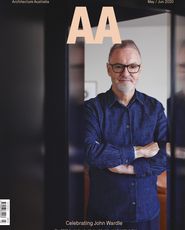
Project
Published online: 29 Sep 2020
Words:
Conrad Hamann
Images:
Brett Boardman
Issue
Architecture Australia, May 2020

